Reading B: Fairie Queen
What Britomart Saw in the Enchanted Chamber/Britomart: A Wicked Enchanter
The scenes where Britomart is in the Enchanted Chamber and fights the Wicked Enchanter were the most entertaining to me! I liked the descriptions of the people who were beside the Enchanter specifically, because they were really vivid.
- Britomart hides in the castle and suddenly a whirlwind sweeps through the house
- a person walks through the middle of the house, he's wearing comfy robes and on his robe in golden letters is written: Ease
- a band followed and then a procession of several couples:
- Fancy: outfit bright and painted with a big fan & Desire: extravagantly dressed, hands on fire
- Doubt: faded clock, leaning on a broken reed & Danger: wearing bears skin, holding a net in one hand and a blade in another (named Mischief and Mischance)
- Fear: armed but very pale and afraid & Hope: beautiful girl holding a vial of dew
- Dissembling: gentle but fake, holding two clues of silk & Suspicion: ugly, scowling, screen in front of his face
- Grief: hanging his head holding a pair of pincers & Fury: wearing rags holding a firebrand
- Displeasure: heavy, sullen, wasp in a bottle & Pleasure: cheerful and fresh, has a honey laden bee in a bottle
- after them comes the beautiful lady held captive and then the Tyrant of the Castle (Love), riding on a lion
- lots of other random people follow after
- Britomart waits til the next day to try to help the beautiful lady
- in the morning, she finds the lady tied up in the same room as the Wicked Enchanter
- she fights the Enchanter and overpowers him, and forces him to free the lady, who is named Amoret
- Once the Enchanter frees Amoret from the spells, the house is totally changed
- the two women leave but find that Sir Scudamour and the squire have already left
 |
| A scary castle |
Bibliography: Stories from the Faerie Queene by Mary Macleod, with drawings by A. G. Walker (1916).
Comments
Post a Comment